Thierry Noir in front of his work at the Berlin Wall, 1986.
Street art is dangerous. In creating such work, artists expose themselves to fraught circumstances, including the possibility of arrest, or at times worse.
Consider the moment of creation. From Keith Haring’s radiant free sprays of paint to Banksy’s subversive stencils, each iconic image of street art was created quickly, in a flash of time when the artists were subject to extreme risks to their personal safety. Working in these perilous conditions frequently requires artists to simplify their technique to avoid consequences. As the street artist Stik once said of his iconic figures, “Six lines and two dots was the quickest way to draw a human figure without getting caught.”
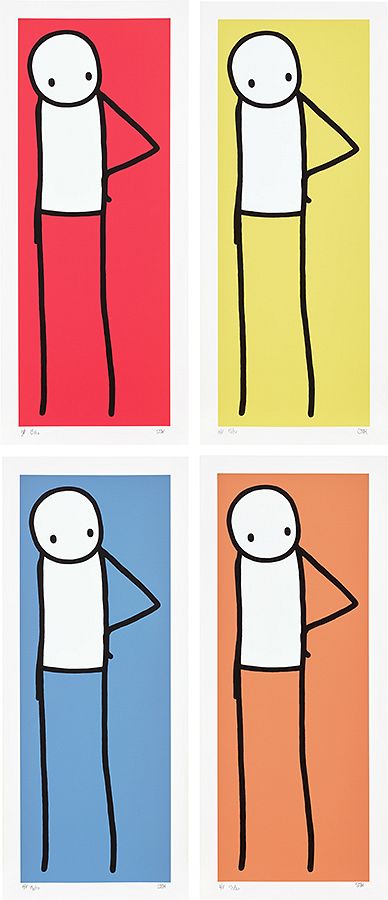
Stik, Hip, 2013. Evening & Day Editions London.
Six lines and two dots was the quickest way to draw a human figure without getting caught.
—Stik
In the case of these selected works on offer in our upcoming Evening & Day Editions auctions in London, each artist’s street work has developed into iconic imagery. It is important to remember that, as pervasive as these images are, their creation is directly tied to moments of personal risk. Perhaps it is that sense of urgency, the fact that the artist was willing to sacrifice so much in the act of creation, which imbues these images with remarkable poignancy. A simplified style may be born of necessity, but the result can present a semiotic integrity that is immediately striking and understandable to all. The democratization of these images is regularly considered a gift to the community by both artists and citizens, as Keith Haring once said, “I wanted to work in the street because I wanted to reach the people.” Yet, to governments, street art is routinely seen as a public nuisance that must be controlled to squash criticism or dissent.
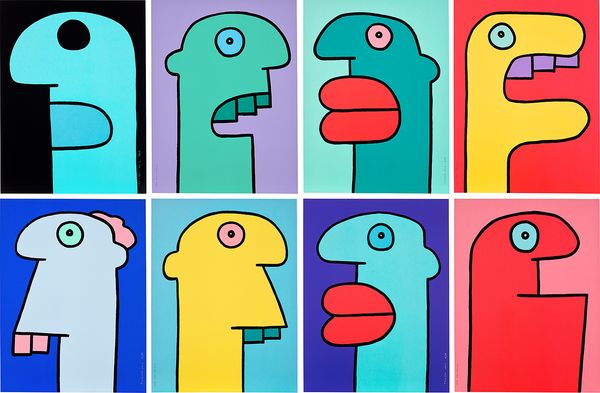
Thierry Noir, East Side Heads, 2014. Evening & Day Editions London.
One such government was the GDR administration that controlled East Berlin. Artist Thierry Noir took many great personal risks in the 1980s to paint massive imagery on the western side of the Berlin Wall, which was, strictly speaking, in East German territory. With his bright and seemingly innocent works painted directly on the symbol of a divided city, Noir sought to overcome the challenges of living in a community fractured by ideological disagreements. When he stood to paint on the wall, the physical space occupied by Noir represented a unique gray area in jurisdiction, as the western-facing front of the wall was constructed on GDR controlled land. Because of this, West Berlin authorities would not have jurisdiction to control any graffiti if they had wanted to. Conversely, the armed watchtowers on the eastern side provided limited sight lines to where Noir would have been standing to paint, making it a challenge for the East German authorities to reach the artist in time to stop him.
As the first artist to paint the Berlin Wall, Noir’s work was a breathtakingly daring feat. He had to work extremely quickly to avoid being caught. He later remarked on these moments to The Gaurdian, recalling, “The guards were no longer allowed to shoot people. But while I was painting, they would still scream, ‘Hey you! I see you! Stop that!’ I always painted as long as possible, and at the last moment I jumped back to West Berlin.” On this deliberate act of political antagonism, the artist proclaimed, “It was time to show those soldiers that an era had finished. With only a spray can or two, I would play cat and mouse with them for hours.”
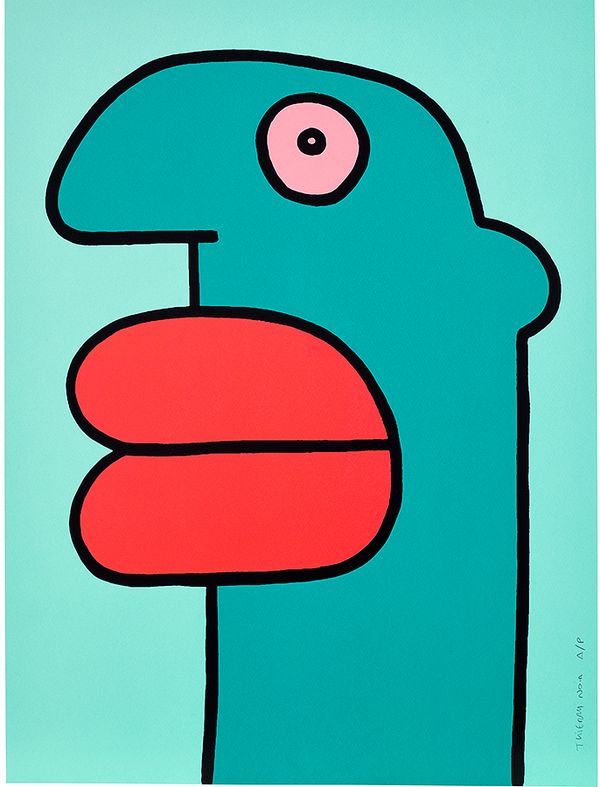
Thierry Noir, East Side Heads (detail), 2014. Evening & Day Editions London.
The guards were no longer allowed to shoot people. But while I was painting, they would still scream, ‘Hey you! I see you! Stop that!’
—Thierry Noir
Noir continued this practice from 1984 until the wall fell in 1989, eventually covering five kilometers of the wall with paintings that questioned social division and challenged authoritarian repression. Working in these circumstances he developed a technique of employing “two ideas, three colors” for the works. The result was a visually striking reduction of forms to their most basic elements and a dramatic emphasis on line. An initiative in 1990 offered Thierry Noir and 117 other artists from 21 countries the opportunity to create works on a remaining portion of the wall. This “East Side Gallery” section is one of Berlin’s most important public artworks and the longest surviving stretch of the wall in existence. As some of the most instantly recognizable and highly charged images to emerge from a street art practice, Phillips is proud to offer the complete portfolio of East Side Heads prints for the first time.
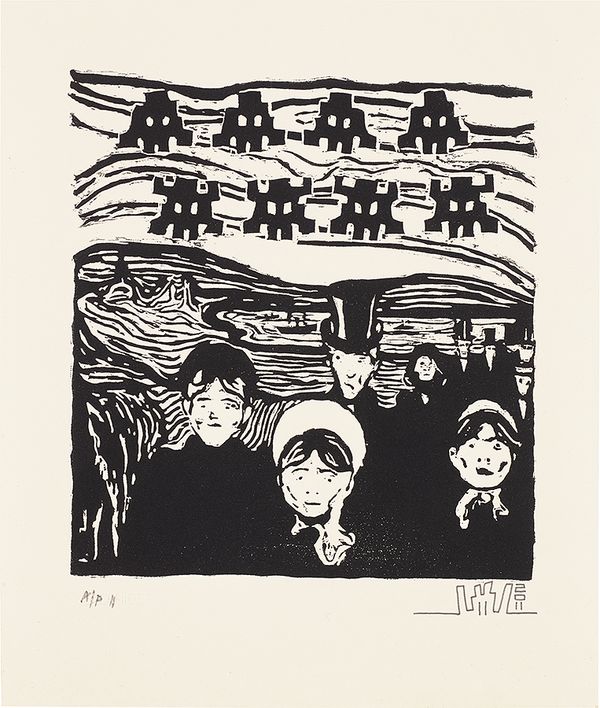
Invader, Invaded Hypnosis, 2011. Evening & Day Editions London.
French street artist Invader is keenly aware that his practice subverts not only art world conventions, but laws set by the state, remarking in a 2013 interview, “99% of my pieces are illegal but I don’t see them like vandal acts but rather like a gift to the city ... Nevertheless, I agree that the line is not always obvious to find and that [it] is not my role to say what is vandalism and what is not.” Invader views himself as a ‘hacker’ of public spaces. Like many street artists, his work seeks to democratize the art world through the creation of works that exist outside the walls of museums and galleries.
Maybe the attitude to invade with no permission is the vandal part of it, but at the end my intention is to add something new, not to destroy the existing things.
—Invader
He achieved notoriety in the 1990s for his guerrilla-style art installations composed of mosaic tiles. These works lean into the nature of the medium to represent seemingly pixelated imagery, frequently employing the iconic Space Invader figures. His strong sense of artistic purpose compels him to take the risks involved in the creation of his work, noting in that same 2013 interview, “In Newcastle I’ve been arrested, pictured, fingerprinted, and they took some of my DNA. When I arrived back in my hotel room, they told me that the police came to search my room!”

Invader, Invaded Hypnosis (detail), 2011. Evening & Day Editions London.
In his quest to challenge the status quo, Invader often employs visual references to the art historical canon. Such is the case with his works from the early 2000s that employ Rubik’s Cubes to transform masterpieces like di Vinci’s Mona Lisa and Warhol’s depictions of Marylin Monroe into vibrantly colored and pixelated works. This distinctive visual lexicon engages with society’s fascination with digital entertainment, computers, gaming, and technology at large.
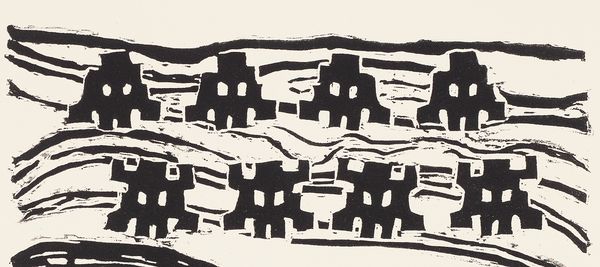
Invader, Invaded Hypnosis (detail), 2011. Evening & Day Editions London.
On offer in our upcoming sales, Invaded Hypnosis appropriates Edvard Munch’s Angst from 1896. Munch’s woodcut utilizes the nature of the medium to convey an uneasy atmosphere. An undulating background constructed with rippling graphic lines conveys an unsettled environment, reinforced by the simplified, ghost-like features of Munch’s alienated figures. Invader adds to Munch’s meditations on isolation and anxiety with a characteristic nod to video gaming — inserting Space Invaders into the sky.
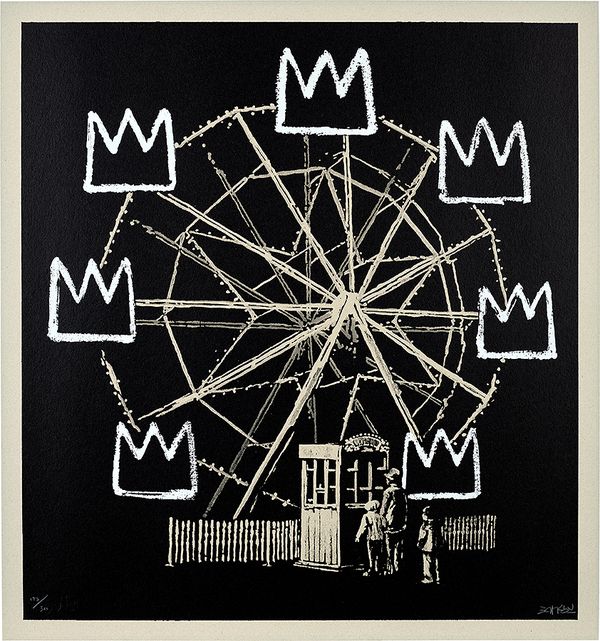
Banksy, Banksquiat (Grey), 2019. Evening & Day Editions London.
Banksy is notorious for his subversions of political, legal, and art-world norms and has achieved such status that his acts of graffiti are regularly considered a public treasure by governments and institutions. For example, consider his intervention on the walls of the Barbican, Banksquiat. First executed ahead of the exhibition “Basquiat: Boom for Real” — the first major retrospective in Britain dedicated to Jean-Michel Basquiat, who himself rose to fame in the late 1970s through the New York graffiti scene — the present work borrows imagery from Basquiat and appeared alongside an image of London Metropolitan Police officers frisking the two titular figures of Basquiat’s 1982 painting Boy and Dog in a Johnnypump. The placement of the two images near a sign pointing towards the “Barbican Exhibition Halls” plainly invites viewers to question the complex politics at play in the encounter between the Barbican, the street, Basquiat, and Banksy — even if they never set foot in the exhibition.
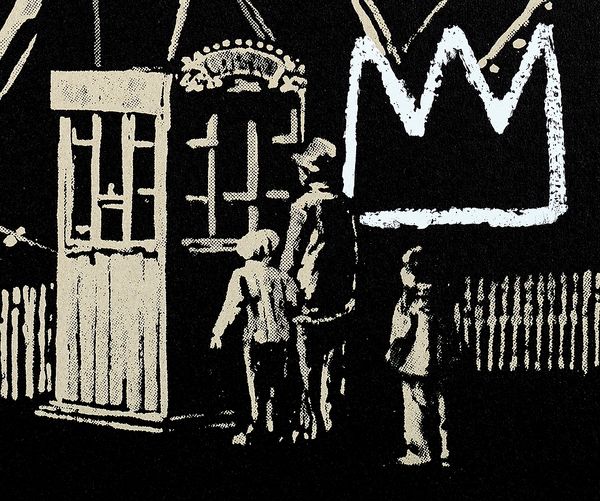
Banksy, Banksquiat (Grey) (detail), 2019. Evening & Day Editions London.
It is intriguing that these works have been maintained and allowed to remain on public property when other iconic images by the artist have not. In 2009, a large-scale mural was removed from a Royal Mail building by the Council of Westminster. Robert Davis, the deputy leader of Westminster council explained, “I take the view that this is graffiti and if you condone this then what is the difference between this and all the other graffiti you see scrawled across the city?” The notable mural in question depicted the text “One nation under CCTV” as being painted by a red-hooded child on a ladder, while a brown dog kneels by a police officer who is shown filming the scene with a camera. The government response to remove the work perhaps reflects their unease with its message. “If you condone this then you condone graffiti all over London,” Davis said. A spokesperson for Royal Mail was less interested in removing the work, stating, “We are having to do this simply because we have been told to.”
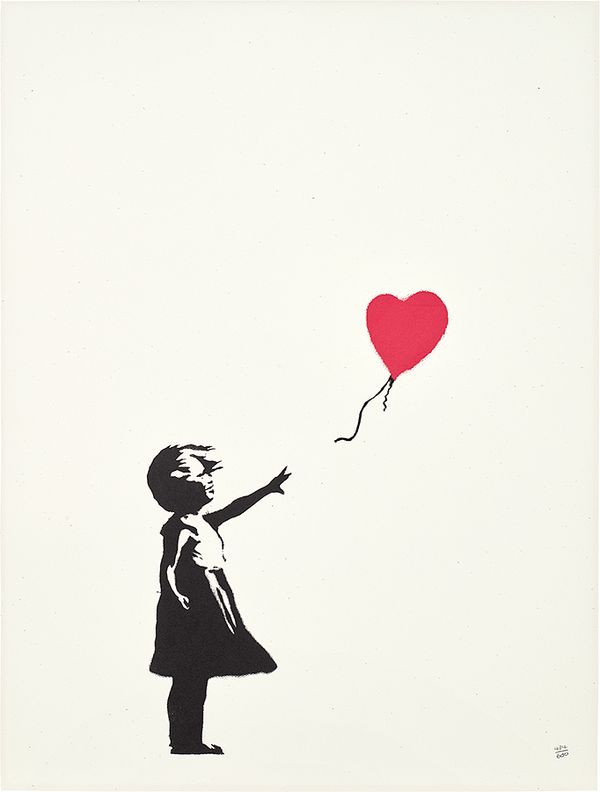
Banksy, Girl with Balloon, 2004. Evening & Day Editions London.
The risk for any street artist then, is not simply in criminal exposure and retribution, but in having their work defaced or removed at the whim of the government. Take for instance Banksy’s Girl with Balloon, a print of which is on offer in Phillips’ upcoming sales. This poignant depiction of a child either losing her grip on a red balloon, or setting it free, oscillates between innocence and nostalgia, loss and regret. Originally inscribed with the text “There is always hope,” the image has become a universally known symbol of a touching positivity in the face of dark times — a message that has resonated globally in a fraught political landscape. Arguably the most well-known Banksy image, the work was even voted as the United Kingdom’s favorite artwork in 2017. Initially graffitied on London’s Waterloo Bridge, the work was later removed by the city council.
“Banksy’s art belongs in a museum,” Councilor Robert Davis had previously proclaimed, not on public buildings. Banksy, and indeed any street artist, must vehemently disagree.
Recommended Reading
Specialists' Picks: Editions London at 10 Years >
